|
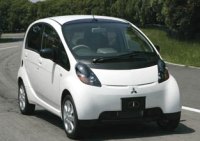 If
Mitsubishi i were born in the 1960s, people would have thought it come
from Mars. Strangely, the philosophy behind i and Smart Fortwo are so
close - both of them are small city car powered by a rear-mounted
engine, but the Mitsubishi doesn't look very smart. Instead, its
organic shape looks weird, like a vehicle from space creatures. And
unquestionably, judging from the taste of its design, those space
creatures must not be Mr. Spock of Star Trek, but those man-eating big
insects or octopuses ! If
Mitsubishi i were born in the 1960s, people would have thought it come
from Mars. Strangely, the philosophy behind i and Smart Fortwo are so
close - both of them are small city car powered by a rear-mounted
engine, but the Mitsubishi doesn't look very smart. Instead, its
organic shape looks weird, like a vehicle from space creatures. And
unquestionably, judging from the taste of its design, those space
creatures must not be Mr. Spock of Star Trek, but those man-eating big
insects or octopuses !
Strange look aside, the focus of the i must be its rear-engined
configuration. You might remember many of the world's best selling
small cars in the past were driven by rear-mounted engines, such as
Volkswagen Beetle, Fiat 500 and Fiat 126. But the rear-engine era was
ended by Sir Issigonis's Mini, whose transversely-mounted front engine
and front-wheel drive configuration used space even more efficiently.
Moreover, placing more weight to the front instead of the rear can make
the car "safer" to handle, because it is more likely to understeer
rather than oversteer. That's why since the 70s the automotive world
has been dominated by FF cars.
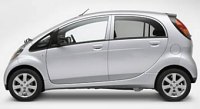 Just
like Smart, the Mitsubishi mini car returns to rear engine because it
wants to satisfy the increasingly high crash protection standard while
providing more interior space out of a small package. Yes, a small
package is very important to i because it is bounded by the Japanese
kei-car regulation (3.4 meters long and 1.48 meters wide) in order to
enjoy tax benefits. To deal with crash test, the i has its 660 cc
3-cylinder engine located underneath the luggage compartment and drives
the rear wheels. In this way, a large crumple zone is left up front.
Mitsubishi can therefore shorten its front overhang and move its cabin
forward. By doing so, the wheelbase is stretched to 2550 mm, some
130-190 mm longer than other kei-cars on the market. This mean the i
offers plenty of legroom as well as smoother ride quality. Just
like Smart, the Mitsubishi mini car returns to rear engine because it
wants to satisfy the increasingly high crash protection standard while
providing more interior space out of a small package. Yes, a small
package is very important to i because it is bounded by the Japanese
kei-car regulation (3.4 meters long and 1.48 meters wide) in order to
enjoy tax benefits. To deal with crash test, the i has its 660 cc
3-cylinder engine located underneath the luggage compartment and drives
the rear wheels. In this way, a large crumple zone is left up front.
Mitsubishi can therefore shorten its front overhang and move its cabin
forward. By doing so, the wheelbase is stretched to 2550 mm, some
130-190 mm longer than other kei-cars on the market. This mean the i
offers plenty of legroom as well as smoother ride quality.
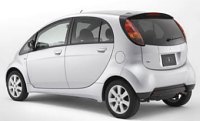 The 660
cc three-pot engine is a new development. Mitsubishi will also supply
it to the next generation Smart Fortwo. It has double overhead
camshafts, 12 valves, MIVEC variable valve timing, a turbocharger and
an intercooler to produce 64 horsepower, the maximum allowed by kei-car
regulation. As a city car, it provides sufficient punch. Unfortunately,
the 4-speed automatic gearbox eats some of the power. Mitsubishi is
short of cash to develop CVT, so we had better to wait for the manual
gearbox when it go on sale in Europe next summer. In the
congestion-filled streets of Tokyo, people should be satisfied with the
smooth shifting automatic gearbox and the useful torque the engine
offers at low speed. However, once you get on the highway, as many
people travel to countryside at the weekends, the engine gets noisy and
breathless. Mitsubishi's small engine seems less refined that those
offered by Daihatsu. The 660
cc three-pot engine is a new development. Mitsubishi will also supply
it to the next generation Smart Fortwo. It has double overhead
camshafts, 12 valves, MIVEC variable valve timing, a turbocharger and
an intercooler to produce 64 horsepower, the maximum allowed by kei-car
regulation. As a city car, it provides sufficient punch. Unfortunately,
the 4-speed automatic gearbox eats some of the power. Mitsubishi is
short of cash to develop CVT, so we had better to wait for the manual
gearbox when it go on sale in Europe next summer. In the
congestion-filled streets of Tokyo, people should be satisfied with the
smooth shifting automatic gearbox and the useful torque the engine
offers at low speed. However, once you get on the highway, as many
people travel to countryside at the weekends, the engine gets noisy and
breathless. Mitsubishi's small engine seems less refined that those
offered by Daihatsu.
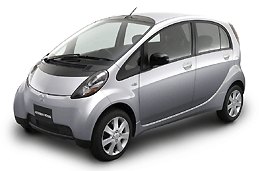 Predictably,
the suspension setting of the Japanese car biases strongly towards ride
comfort without consideration for handling fun. By using a set of front
tires narrower than the rear, Mitsubishi successfully turned oversteer
crisis into understeer - something learned from Smart. Unfortunately,
the front end grip is so weak that understeer occurs too soon, so this
car has no much driver appeal. And we haven't mentioned the body roll
yet ! this car and Smart teach us one lesson: rear-wheel drive does not
guarantee driving fun. Predictably,
the suspension setting of the Japanese car biases strongly towards ride
comfort without consideration for handling fun. By using a set of front
tires narrower than the rear, Mitsubishi successfully turned oversteer
crisis into understeer - something learned from Smart. Unfortunately,
the front end grip is so weak that understeer occurs too soon, so this
car has no much driver appeal. And we haven't mentioned the body roll
yet ! this car and Smart teach us one lesson: rear-wheel drive does not
guarantee driving fun.
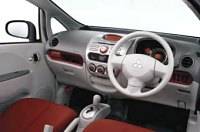 Inside,
the cabin provides plenty of head and legroom for four people, although
shoulder room is typically tight. The organic interior design is not
much better than the exterior, and the nasty plastic in the
pre-production car is worrying. This might be improved when it go on
sale in Japan next January. Unlike that, the small luggage space won't
be altered. Although the engine tilts 45 degrees rearward to reduce its
height, the boot floor is still inevitably higher than regular
hatchbacks. The is the price it pays for the rear engine configuration.
Strangely, there is no secondary luggage compartment up front. So what
is inside the space between the nose and the cockpit ? my guess is: it
possibly hides a pair of electronic beam laser gun. Once the
high-intelligence octopus press a button, the guns pop out and destroy
"earthman"… Inside,
the cabin provides plenty of head and legroom for four people, although
shoulder room is typically tight. The organic interior design is not
much better than the exterior, and the nasty plastic in the
pre-production car is worrying. This might be improved when it go on
sale in Japan next January. Unlike that, the small luggage space won't
be altered. Although the engine tilts 45 degrees rearward to reduce its
height, the boot floor is still inevitably higher than regular
hatchbacks. The is the price it pays for the rear engine configuration.
Strangely, there is no secondary luggage compartment up front. So what
is inside the space between the nose and the cockpit ? my guess is: it
possibly hides a pair of electronic beam laser gun. Once the
high-intelligence octopus press a button, the guns pop out and destroy
"earthman"… |